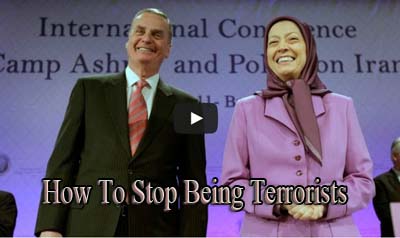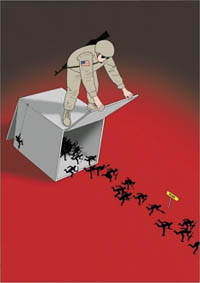An Iranian group shows that as long as you stop being violent, it’s possible to gain supporters in the U.S. government and get removed from the Foreign Terrorist Organizations list — especially if your end-game is to overthrow the current Iran regime and take over.
Transcript:
WASHINGTON — While the world’s eyes are focused on ISIS [the Islamic State of Iraq and Syria] and rising tensions in the Middle East, a former terrorist group from Iran is tromping through the halls of Congress, and garnering support from some of America’s most powerful and prominent politicians and officials.
Speaker: “Howard Dean, Ed Rendell, Patrick Kennedy, and many others.”
The group is the People’s Mujahedeen of Iran, or the MEK, in its Persian acronym. It was taken off of the State Department’s Foreign Terrorist Organizations list [in 2012] after demonstrating that it had not been engaged in terrorist activities for the last 10 years.
The group is led by Massoud Rajavi, who has been in hiding since 2003, when the United States and Britain invaded Iraq, and Maryam Rajavi, who acts as the president-elect of the National Council of Resistance of Iran, the group’s political wing.
According to the FBI, the MEK murdered American citizens in Iran during the 1970s, allied with the ayatollahs to help overthrow the Iranian government, participated in the American embassy hostage crisis in 1979, and teamed up with Saddam Hussein to fight their own countrymen during the Iran-Iraq War.
They are responsible for the deaths of thousands of Iranians and a campaign of bombings, assassinations, and military attacks, as well as collusion with Iraq.
The goal of the group now is to overthrow the current Iranian regime and take power for themselves.
So how does a group go from being one of the most dangerous terrorist organizations in the world to having an office on Pennsylvania Avenue in Washington, D.C., with backing from the likes of the former U.S. Ambassador to the U.N. John Bolton and former Director of Homeland Security Tom Ridge, among many others?
CNN: “There’s been a lot of pressure in the United States both from the group and from its supporters in Congress, and very high-paid former officials speaking on their behalf to delist the group.”
In 2011, groups around the country acting as front organizations for the MEK — including the Iranian American Community of Northern California — hired lobbyists to help remove the MEK from the Foreign Terrorist Organizations list.
They recruited the likes of Howard Dean, who is a former Democratic presidential candidate; Michael Hayden, the former CIA director; Newt Gingrich, who is the former Speaker of the House; and the lobbying firm Akin Gump Strauss Hauer & Feld, among many others. They [MEK] often paid five-figure speaker fees to individuals, and six figures to the firms lobbying on their behalf.
Jeremiah Goulka: “They’re just thorough PR jobs, that do a very good job of making lawyer-like arguments based on taking very nit-picky looks at wording.”
That’s Jeremiah Goulka, the author of “The Mujahedin-e Khalq in Iraq: A Policy Conundrum,” a report published by the Rand Corporation in 2009 that assesses the status of the MEK at a camp called Ashraf in Iraq.
Goulka: “I was asked to join the Rand Research Team. … Who are the MEK? Why are they there in Iraq? What should the detainee operations command do, if anything?”
However, following publication, the Rand report came under fire by the MEK and its paid lobbyists in Washington.
Lincoln P. Bloomfield: “Well, I’m a former policy official and one of my roles is as a consultant to a law firm in Washington. An American citizens group hired the law firm to help them advocate to remove the MEK from the terrorism list.”
That’s Ambassador Lincoln P. Bloomfield, the former deputy assistant secretary of state for Near Eastern Affairs from 1992 to 1993. He wrote a book, entitled “The Mujahedin-e Khalq, MEK: Shackled by a Twisted History,” that posits that the MEK has been severely misunderstood over time.
Bloomfield: “I found out that there’s a gap between what everyone was saying about the MEK and what the information seemed to show, that there was a gap, something was amiss. So that really piqued my curiosity and I just kept digging for the next two years.”
Ambassador Bloomfield’s law firm, Akin Gump Strauss Hauer & Feld, was reportedly paid $620,000 dollars by a group supportive of the MEK during those two years, according to the Senate Office of Public Records.
But are his claims — which match those of the MEK — true?
Bloomfield: “As I began to examine what think tanks were saying, what the press was saying, a very consistent set of allegations arose: that they’d killed Americans in the 1970s in Iran, that they had helped with the embassy hostage takeover during the revolution in 1979, that they were a violent, left-wing, Marxist group that was speaking about democracy but didn’t really mean it, and that they’d engaged in a whole series of violent actions, and that they were also human rights abusers in their own midst.”
In June 1973, Lt. Col. Lewis Hawkins of the U.S. Army was the first American assassinated by the MEK, as he walked near his home in Tehran, according to The Associated Press.
Ambassador Bloomfield claims that Hawkins was murdered by a man named Vahid Afrakhteh, citing two Washington Post articles from 1976.
This is significant because the MEK narrative has attempted to gain credibility in the United States by separating itself from the killing of Americans.
Bloomfield: “Other activists who were impatient with the MEK took the Mujahedeen name and weren’t interested in Islam, and they wanted a secular Marxist, violent revolution, and they were the ones who killed the Americans. They were caught. I have put The Washington Post articles from those days in my report.”
The Washington Post articles are referenced as proof that a U.S. State Department report on the MEK is problematic — and possibly untrue — because it says Reza Rezai, not Afrakhteh, “was arrested and executed by the Shah’s government for the murder of Colonel Hawkins.”
The MEK and its supporters are trying to separate Rezai from the killing of Lt. Col.
Hawkins because even though he is dead, he is still idolized by the current MEK as a hero.
However, while it may be true that Afrakhteh committed the actual murder of Hawkins, two separate reports from The Associated Press in 1973, obtained by MintPress News, named Reza Rezai as the “man alleged to have planned the murder of… Lieutenant Colonel Lewis Hawkins” and as the leader of the group. One of the reports says, “The gunman who killed Hawkins still is at large.”
That person who was “still at large” very well could have been Afrakhteh, so the fact he is named as the actual gunman does not in any way absolve Rezai from responsibility for the murder, nor does it contradict the State Department report.
The MEK also claims, as does Ambassador Bloomfield, that it is separated from the murder of the seven Americans, including Lt. Col. Hawkins, because there was a schism in the group between a Marxist-leaning faction, and the Muslim faction led by Massoud Rajavi.
Bloomfield: “There was blood between the two factions. The one that wanted Islam is the one that we see today, and for their commitment to Islam a couple of people were gunned down by these leftist revolutionaries, who were using the name Mujahedin.”
However, that schism did not happen until 1975, according to Ervand Abrahamian, author of “The Iranian Mojahedin,” and one of the foremost scholars of the group. Therefore, in the words of Muhammad Sahimi, “Hawkins’ assassination, at least, was irrefutably the work of the original” MEK.
Another problem with the narrative of the MEK not being involved with the killings of Americans is that the group bragged about those murders in its very own newspaper called “Mojahed,” seen here.
The text states:
“It was the Mujahedin-e Khalq that killed with guns American Generals and also blew up nests of spies, like America’s information office… ”
[Mojahed – Number 77, Page 2]
The MEK and its supporters also claim that the group was not involved with the U.S. Embassy hostage crisis and that it did not support it in any way.
Bloomfield: “This one is very black and white, and misunderstood. And, frankly, allegations that the MEK were behind the embassy takeover, and were promoting keeping the Americans hostage only surfaced in detail a few years ago.”
The problem with this statement is that the MEK clearly promoted the 1979 embassy takeover in its newspaper.
The headline to the article in this issue of “Mojahed” says:
“We are happy that this time they targeted the real Shah, which is America’s imperialism; The nest of the spies has been seized!”
[Mojahed – Number 10, Front page, November 12, 1979]
Further, despite an intense campaign to expunge the MEK’s troubled history toward the safety and well-being of American citizens and the way it treats its own members, the State Department, the FBI, Human Rights Watch, and the Rand Corporation have not changed their stance on any of these issues.
So, what is the MEK? The aforementioned organizations claim that not only is it an opposition group to the current Iranian regime, but it is a kind of cult.
Goulka: “At the MEK camps, there’s a whole set of practices that are all textbook out of cult theory – sleep deprivation, make-work projects, which is one of the reasons why Camp Ashraf has all this — surprisingly, it’s pretty. I mean there’s all of these beautification projects there. There’s fountains and there’s gardens, and there are all of these statues and memorials to things. Make-work projects. Sometimes food limitation. But one of the big things I didn’t know about them, the stuff that gets at people, um: 1) forced celibacy; 2) forced divorce; 3) gender segregation. They will claim that the divorce was not forced. One of their representatives told me that, I don’t remember his exact words, but that in the desert, it just doesn’t support family life. And I’m sure that Iraqi families feel just the same way.”
Masoud Banisadr was an MEK member for 20 years and served as the group’s representative to the United Nations and the United States during that time. He now ardently denounces the group. His account of what it’s like on the inside supports Goulka’s claims.
Masoud Banisadr: “Not only me, all members were forced to divorce their spouses, and later they have to send their children abroad to Europe and United States to be adopted by supporters and other members. The final stage was self-divorce, which meant that you have to divorce your own personality, your own individuality. You had to prove to the group that your whole individuality and personality before you become member of the group were devilish and wrong and corrupt and so-on.”
The MEK and its supporters claim that the group is not a cult, though, and that former members have been coerced into saying that it is a cult by Iran’s intelligence services.
Goulka: “This is what’s important to remember: Even if there are Iranian efforts to paint the MEK as terrible, which there are — I mean, the Iranian regime is always trying to make the MEK look terrible. But, it’s easy to make the MEK look terrible because the MEK looks terrible.”
Part of Goulka’s job in Iraq when assessing the MEK camp was to interview members of the group.
Goulka: “I mean, I interviewed loads of people, and, I mean, were they all agents? I doubt it. Were they Iranian agents, were they sneaking into the locked-off refugee camp off of F.O.B. [Forward Operating Base] Grizzly, and planting information to somehow feed me when they did not know I was coming?”
In response to the MEK’s claims, Human Rights Watch even went back and re-assessed their reporting and re-interviewed the original people from their report.
The second time around, they made the same claims that the organization is a cult and that they [members of the group] were tortured and abused by MEK’s leaders.
Human Rights Watch found no evidence of influence by Iranian intelligence services.
Despite all the documented history behind the group’s nefarious claims, it still came off the [Foreign Terrorist Organizations] list. And that’s because the single most important thing it did was end all acts of violence. And on this point, both Goulka and Ambassador Bloomfield agree.
Bloomfield: “In September of 2012, when Secretary of State Clinton removed the MEK from the U.S. terrorism list, the announcement said that the MEK had conducted no acts of violence for at least 10 years.”
Goulka: “I was actually thinking they should come off the list. I don’t think the U.S. made the decision for the right reasons, but I think they made the right decision. I think they needed to come off the list because I think the list, as written — I mean, the statute as written — they no longer really satisfied. And I think it’s important that there be some kind of incentive to terrorist groups in the world to say, ‘You know, if you stop being violent, we will take you off the list.”
So now that the MEK is no longer officially considered a terrorist group, what is it? How are they any different from other Iranian opposition groups, such as the National Front, or supporters of the previous monarchy?
Banisadr: “This is the problem which they are facing. I mean, the kind of questions that they face from ordinary Iranians outside of Iran, or their supporters outside of Iran is: How do you want to go back to Iran? How do you want to overthrow this government? The only answer which they have is that, ‘We are lobbying the United States. We are lobbying Western countries to fight against the Iranian government. First to put sanctions, put hardship on Iranian government so they cannot solve the problems of [the] Iranian people. And this might create some resistance on the opposition within Iran, and create an environment of revolution, perhaps, inside of Iran. At the same time, we are inviting Western countries, especially [the] United States to attack Iran because of [the] nuclear issue, because of [the] Israeli issue, and so on. So, when [the] United States attacks Iran the only the only people that can govern the country are us. There is nobody else.’”
Goulka agrees with Banisadr’s assessment of the group. He echoed his remarks about the MEK trying to grab power in Iran through pressuring the American government, but from a perspective rooted in the shame behind the horrors of America’s invasion of Iraq in 2003.
Goulka: “We’re always trying to make it sound like Iran is so super powerful as a military force. And it’s nothing compared to Israel, which is nothing compared to us. Yet we’re going to get ourselves up into a lather where the only, the only end result of that, the only logical end result if you let it keep going, is that we get violent with Iran. And that doesn’t suit anybody’s interests, without even questioning the actual morality of it. I mean, do I support the Iranian regime? No. But when you look at what we did to Iraq, where now people in the media constantly talk about 100,000 civilians dying as if that’s something we should accept. And most evidence suggests that’s like one-tenth of the people that actually died. And that’s death — that’s not the number of people who are just displaced, or injured, or had their lives ruined. The millions of people who were displaced and had to leave the country, or just displaced in the country – I mean, we wrecked that country because some people here wanted to do it, and you had fools like Ahmed Chalabi saying that they could go in and take over the place, and our fools who followed it. And the number of deaths for our people, too, and the way we’ve ruined lives here, and the way we’ve, you know, the money we’ve spent on it. Why would we repeat that in Iran? I mean, it’s insane. But, of course, insanity is the whole notion, you know, thinking you can do it again right this time. And it’s just frightening to watch us go down that path if we keep listening to the MEK.”
For MintPress News in Washington, this is Sean Nevins.
Download How To Stop Being Terrorists




